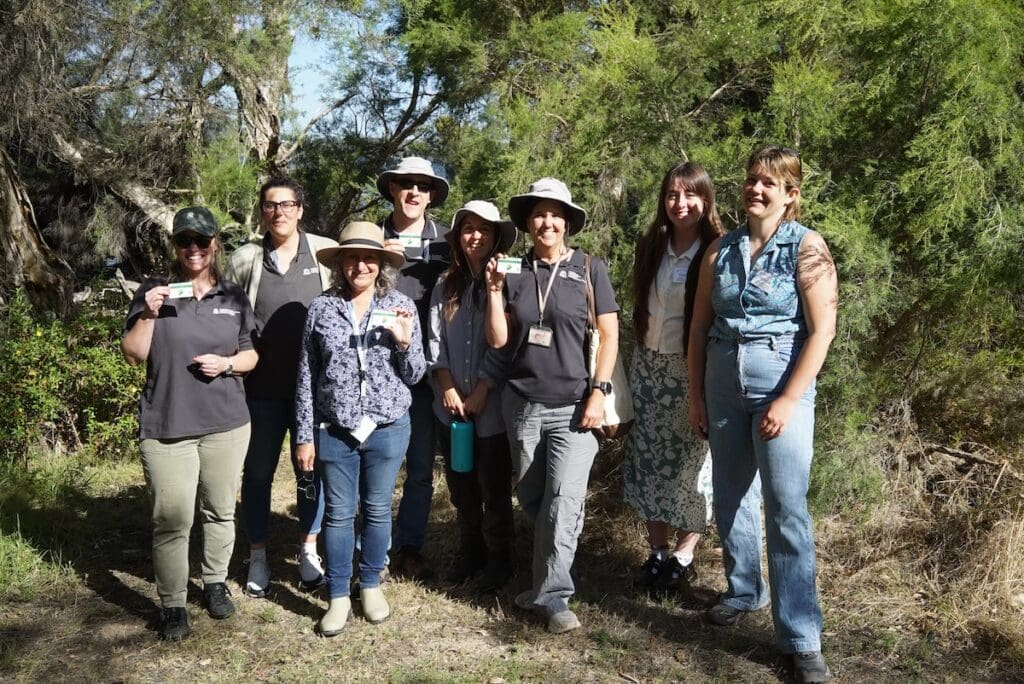Diagnosing the presence of Phytophthora disease is known as ‘interpretation’ and originates from a WA Forests Department program that was developed in the 1970s. The task of Dieback Interpretation is complex and to minimise error, Dieback Interpreters follow a logical process of evaluating historic and recent site information, aerial imagery, observing indicator (susceptible) plant deaths, collecting and analysing field data and recording a range of observable site factors.
While laboratory testing of soil and plant tissue samples provides positive identification of Phytophthora species, negative results alone cannot be used to represent a total absence of Phytophthora in sampled areas in bushland, water bodies and raw materials extraction areas.
There are two options to determine if Phytophthora Dieback is present on your land:
- Engage a Consultant Dieback Interpreter; or
- Do it yourself (Note: there is a greater chance of misdiagnosing with this option).
Dieback Interpreters follow the logical process of diagnosis outlined above and are registered by the Department of Biodiversity Conservation and Attractions, to maintain quality standards. They can also map the spatial distribution on the disease across landscapes to enable Disease Management Plans to be developed. The cost for Dieback Assessment will vary depending on the size and location of the subject area. It is a wise investment to contact an expert rather than mis-diagnose this problem. Experts can rapidly eliminate other causes of plant deaths that mimic Phytophthora including, but not limited to drought, insect damage, other pathogens, herbicide/chemical contact and trees do die naturally over time.
Discuss costs with your consultant prior to the work being undertaken. Community groups can apply for funding grants from various sources to cover the cost of disease diagnosis and mapping. For more information on potential funding sources and what Dieback Management occurs in your locality, contact your local government Environmental Officer and Natural Resource Management organisation.
DWG highly recommends contacting an expert to ensure the best advice.
You can complete your own “initial” disease survey by studying the plants in your garden/bushland. You need to have a very good knowledge of native plants, various disease symptoms and other causes of plant deaths for the results of your survey to be reliable.
The presence of Phytophthora Dieback can be made by observing susceptible plant symptoms where they are found to be dead and dying. These susceptible plants are called “indicator species”. Jarrah, banksia, grasstrees, zamia palms, Dryandra and hakea are some commonly-used indicator species. You must be able to separate other factors that have caused plant deaths, such as fire, insects, flood, drought, nutrient deficiencies or toxicities, and other plant diseases.
As well as observing indicator species deaths, a good quality aerial photograph may assist you to identify and mark on it any additional areas of dead vegetation to check as well as site access tracks and pathways where the disease may have been introduced.
Tables 1 and 2 lists some common plant species and genera from the jarrah forest and Swan Coastal Plain that are susceptible to Phytophthora cinnamomi, and are commonly used as Phytophthora Dieback indicator species.
Jarrah Forest |
Swan Coastal Plain |
| Adenanthos cygnorum – woolly bush | Adenanthos cygnorum – woolly bush |
| Allocasuarina fraseriana – sheoak | Adenanthos sericea |
| Banksia grandis – bull banksia | Banksia attenuata – slender banksia |
| Banksia littoralis – swamp banksia | Banksia littoralis – swamp banksia |
| Banksia sessilis – parrot bush | Banksia menziesii |
| Eucalyptus marginata – jarrah | Conospermum stoechadis – smoke bush |
| Isopogon sphaerocephalus | Banksia nivea – couch pot dryandra |
| Leucopogon verticellatus – tassel flower | Banksia sessilis – parrot bush |
| Macrozamia reidlei – zamia palm | Hibbertia hypercoides |
| Patersonia rudis – hairy flag | Isopogon formosus – cone flower |
| Persoonia elliptica | Lomandra odora – tiered mat rush |
| Persoonia longifolia – snotty gobble | Macrozamia reidlei – zamia palm |
| Xanthorrhoea gracilis – slender grasstree | Verticordia nitens |
| Xanthorrhoea preisii – grasstree | Xanthorrhoea species – grasstree |
Table 2. Plant genera with species known to be affected by Phytophthora species – including P. cinnamomi (CALM, 1999b)
Proteaceae |
Myrtaceae |
Epacridaceae |
Other |
| Adenanthos | Agonis | Andersonia* | Allocasuarina |
| Banksia* | Beaufortia | Astroloma* | Anarthia |
| Conospermum | Calothamnus | Leucopogon* | Boronia |
| Dryandra | Calytrix | Lysinema* | Conostylis |
| Franklandia | Eremaea | Monotoca* | Dampiera |
| Grevillea | Eucalyptus | Sphenotoma* | Dasypogon |
| Hakea | Hypocalymma | Styphelia* | Daviesia |
| Isopogon* | Kunzea | Eutaxia | |
| Lambertia* | Melaleuca | Gastrolobium | |
| Persoonia* | Regelia | Hibbertia* | |
| Petrophile* | Scholtzia | Hovea | |
| Stirlingia* | Thryptomene* | Jacksonia | |
| Synaphea | Verticordia* | Lasiopetalum* | |
| Xylomelum | Latrobea | ||
| Macrozamia | |||
| Oxylobium | |||
| Phlebocarya | |||
| Xanthorrhoea | |||
| Xanthosia |
*Many species in the genus are severely affected.
For a more detailed list of resistant and susceptible plant species please consult the Centre for Phytophthora Science and Management website (www.cpsm.murdoch.edu.au).
Total plant/tree death – Phytophthora Dieback can kill susceptible plants completely and quickly. Most plants do not die one branch at a time, and there is usually no chance of recovery. For example, an infected banksia often suffers from sudden death. In contrast, the foliage cover on jarrah trees may decline for a number of years, turning yellowish to brown when dead.
Other observable factors may be present in natural environments that support the diagnosis of disease presence or absence such as:
- Look for something that could have introduced (vectored) the disease, for example, a track, road or vehicle activity.
- Chronology of plant deaths;
- Patterns of plant deaths;
- Topography and site drainage characteristics;
- Biomass and biological diversity reduction; and
- Lesions and tissue staining under the bark of infected plants.
Ideally, enter bushland when the soil is dry to avoid spreading any infected material stuck to your footwear.
Please remember to Arrive Clean – Leave Clean, during any bushland activity!
Like the professional consultants, you can also take plant and soil samples and have them tested in a laboratory (you can find a list of diagnostic laboratories here). Sample results that are positive for Phytophthora Dieback means that the disease is present at the site. Negative results don’t mean that the site is free of the pathogen, as it may simply have been missed when the sample was taken. The chance of a positive sample being recorded can be significantly increased if the tissue sample is collected from a plant that has a lesion (decaying tissue) present underneath the bark at the base of the main trunk.
You will need to get instructions from the laboratory on how to take a sample, the best time to take the sample and how to store and transport it. Sampling usually involves digging up a dead plant to get to the roots. This can be quite a physically demanding task if you are sampling a banksia or grasstree.


